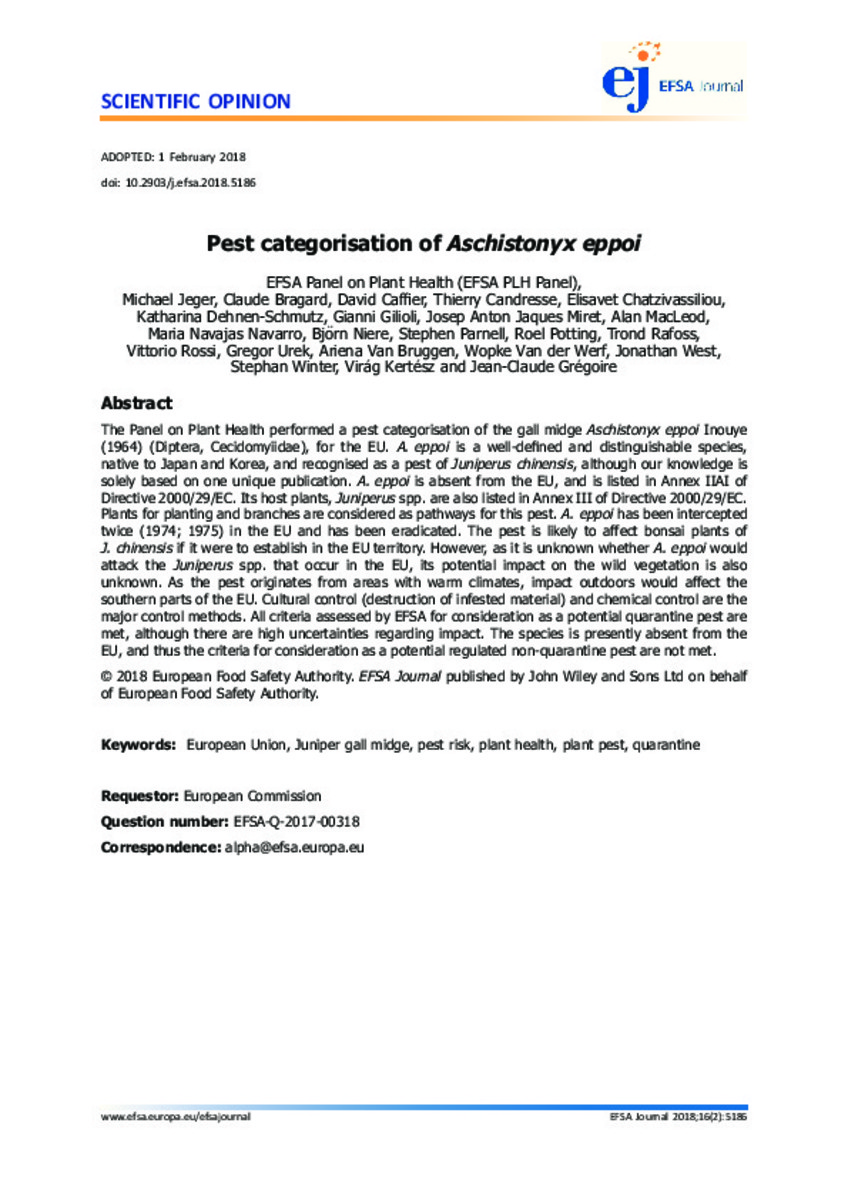Mostrar el registro sencillo del ítem
Pest categorisation of Aschistonyx eppoi
| dc.contributor.author | Jeger, Michael | |
| dc.contributor.author | Bragard, Claude | |
| dc.contributor.author | Caffier, David | |
| dc.contributor.author | Candresse, Thierry | |
| dc.contributor.author | CHATZIVASSILIOU, ELISAVET | |
| dc.contributor.author | Dehnen-Schmutz, Katharina | |
| dc.contributor.author | Gilioli, Gianni | |
| dc.contributor.author | Jaques , Josep A. | |
| dc.contributor.author | MacLeod, Alan | |
| dc.contributor.author | Navajas Navarro, María | |
| dc.contributor.author | Niere, Björn | |
| dc.contributor.author | parnell, stephen | |
| dc.contributor.author | Potting, Roel | |
| dc.contributor.author | Rafoss, Trond | |
| dc.contributor.author | Rossi, Vittorio | |
| dc.contributor.author | Urek, Gregor | |
| dc.contributor.author | van Bruggen, Ariena | |
| dc.contributor.author | van der Werf, Wopke | |
| dc.contributor.author | West, Jonathan | |
| dc.contributor.author | Winter, Stephan | |
| dc.contributor.author | Kertész, Virág | |
| dc.contributor.author | Grégoire, Jean-Claude | |
| dc.date.accessioned | 2018-09-03T10:25:06Z | |
| dc.date.available | 2018-09-03T10:25:06Z | |
| dc.date.issued | 2018-02 | |
| dc.identifier.citation | JEGER, Michael; BRAGARD, Claude; CAFFIER, David; CANDRESSE, Thierry; CHATZIVASSILIOU, Elisavet; DEHNEN-SCHMUTZ, Katharina; GILIOLI, Gianni; JAQUES, Josep A.; MACLEOD, Alan; NAVAJAS NAVARRO, María; NIERE, Bjorn; PARNELL, Stephen; POTTING, Roel; RAFOSS, Trond; ROSSI, Vittorio; UREK, Gregor; VAN BRUGGEN, Ariena; VAN DER WERF, Wopke; WEST, Jonathan; WINTER, Stephan, KERTÉSZ, Virág; GRÉGOIRE, Jean-Claude (2018). Pest categorisation of Aschistonyx eppoi. EFSA Journal, v. 16, n. 2 | ca_CA |
| dc.identifier.uri | http://hdl.handle.net/10234/175948 | |
| dc.description.abstract | The Panel on Plant Health performed a pest categorisation of the gall midge Aschistonyx eppoi Inouye (1964) (Diptera, Cecidomyiidae), for the EU. A. eppoi is a well-de fi ned and distinguishable species, native to Japan and Korea, and recognised as a pest of Juniperus chinensis , although our knowledge is solely based on one unique publication. A. eppoi is absent from the EU, and is listed in Annex IIAI of Directive 2000/29/EC. Its host plants, Juniperus spp. are also listed in Annex III of Directive 2000/29/EC. Plants for planting and branches are considered as pathways for this pest. A. eppoi has been intercepted twice (1974; 1975) in the EU and has been eradicated. The pest is likely to affect bonsai plants of J. chinensis if it were to establish in the EU territory. However, as it is unknown whether A. eppoi would attack the Juniperus spp. that occur in the EU, its potential impact on the wild vegetation is also unknown. As the pest originates from areas with warm climates, impact outdoors would affect the southern parts of the EU. Cultural control (destruction of infested material) and chemical control are the major control methods. All criteria assessed by EFSA for consideration as a potential quarantine pest are met, although there are high uncertainties regarding impact. The species is presently absent from the EU, and thus the criteria for consideration as a potential regulated non-quarantine pest are not met. | ca_CA |
| dc.format.extent | 17 p. | ca_CA |
| dc.format.mimetype | application/pdf | ca_CA |
| dc.language.iso | eng | ca_CA |
| dc.publisher | European Food Safety Authority (EFSA) | ca_CA |
| dc.relation.isPartOf | EFSA Journal (2018), v. 16, n. 2 | ca_CA |
| dc.rights | Attribution-NoDerivatives 4.0 Internacional | * |
| dc.rights.uri | http://creativecommons.org/licenses/by-nd/4.0/ | * |
| dc.subject | European Union | ca_CA |
| dc.subject | Juniper gall midge | ca_CA |
| dc.subject | Pest risk | ca_CA |
| dc.subject | Plant health | ca_CA |
| dc.subject | Plant pest | ca_CA |
| dc.subject | Quarantine | ca_CA |
| dc.title | Pest categorisation of Aschistonyx eppoi | ca_CA |
| dc.type | info:eu-repo/semantics/article | ca_CA |
| dc.identifier.doi | http://dx.doi.org/10.2903/j.efsa.2018.5186 | |
| dc.rights.accessRights | info:eu-repo/semantics/openAccess | ca_CA |
| dc.relation.publisherVersion | https://www.efsa.europa.eu/en/efsajournal/pub/5186 | ca_CA |
| dc.type.version | info:eu-repo/semantics/publishedVersion | ca_CA |
Ficheros en el ítem
Este ítem aparece en la(s) siguiente(s) colección(ones)
-
CAMN_Articles [566]








